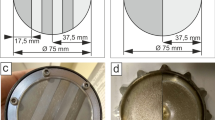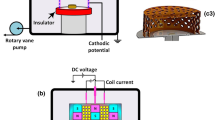Abstract
In this study we have used a combinatorial approach for producing binary and ternary alloy thin film libraries using a lab-scale RF co-sputtering system. Initially we used two elemental sputtering targets, i.e. aluminum (Al) target and neodymium (Nd) target, to produce a film library of varying composition and successfully identified a suitable composition range (1.95–2.38 at% Nd) in which resistance to hillock formation and resistivity of the film spots were found to be satisfactory in annealed state (350°C, 30 min). In another case, in order to form ternary alloy composition library we have used two sputtering targets, i.e. an Al-0.5 at% Nd alloy target and an elemental Ni target. Though, co-sputtered Al-0.6 at% Nd-0.9 at% Ni alloy films showed satisfactory resistance to hillock formation and low resistivity after annealing, film deposited from a ternary alloy target with the same composition failed to show satisfactory resistance to hillock formation during annealing. In case of Al-0.6 at% Nd-0.9 at% Ni alloy target, 250 nm thick film showed poor resistance to hillock formation than the 500 nm thick film. This clearly showed thickness-dependent hillock performance of Al-0.6 at% Nd-0.9 at% Ni alloy. In this study it was found that, in addition to the process variables, metallurgical microstructure of the alloy sputtering targets had significant effect on the film properties which was not obvious from the results of films deposited using co-sputtering of the individual elemental targets.
Similar content being viewed by others
References
Arai T, Liyori H, Hiromasu Y, et al. Aluminum-based gate structure for active-matrix liquid crystal displays. IBM J Res Develop, 1998, 42: 491–499
Onishi T, Iwamura E, Takagi K, et al. Effect of Nd content in Al thin films on hillock formation. J Vac Sci Technol A, 1997, 15: 2339–2348
Onishi T, Iwamura E, Takagi K. Morphology of sputter deposited Al alloy films. Thin Solid Films, 1999, 340: 306–316
Arai T, Makita A, Hiromasu Y, et al. Mo-capped Al-Nd alloy for both gate and data bus lines of liquid crystal displays. Thin Solid Films, 2001, 383: 287–291
Yoshikawa K, Yoneda Y, Koide K. Spray formed aluminum alloys for sputtering targets. Powder Metallurgy, 2000, 43: 198–199
Joshi A, Gardner D, Hu H S, et al. Aluminum-samarium alloy for interconnections in integrated circuits. J Vac Sci Technol A, 1990, 8: 1480–1483
Lee Y K, Fujimura N, Ito T, Annealing behavior of Al-Y alloy film for interconnection conductor in microelectronic devices. J Vac Sci Technol B, 1991, 9: 2542–2547
Hara T, Hosoda N, Nagano S, et al. Stress in Al-Sc interconnection layers. Jpn J Appl Phys Lett, 1993, 32: L1394–L1396
Iwamura E, Onishi T, Yoshikawa K. Influence of formation and decomposition of solid solution on resistivity and hillock suppression in sputtered Al-Ta thin films. J Jpn Inst Met, 1995, 59: 673–678
Onishi T, Iwamura E, Takagi K, et al. Influence of adding transition metal elements to aluminum target on the electrical resistivity and hillock resistance in sputtered-deposited aluminum alloy thin films. J Vac Sci Technol A, 1996, 14: 2728–2735
Takatsuji H, Iiyori H, Tsuji S, et al. Nanometer-scale investigation of Al-based alloy films for thin-film transistor liquid crystal displays. In: Fulks R, Parsons G, Slobodin D, eds. Flat Panel Display Materials III. Materials Research Society Proceedings, vol 471, 1997. 99–104
Takayama S, Tsutsui N. Effects of Y or Gd addition on the structures and resistivities of Al thin films. J Vac Sci Technol A, 1998, 14: 2499–2504
Wang L-P, Chao W-H, Wang S-H, et al. Photoluminescence properties of Mn-doped zinc silicates synthesized by combinatorial sputtering techniques, In: Thadhani N N, Armstrong R W, Gash A E, eds. Multifunctional Energetic Materials. Materials Research Society Symposium Proceedings, vol 896, 2006. LL02-06.1-6
Chao W-H, Wang L-P, Wang S-H, Huang et al. Binary HfO2:SiO2 used as high-k gate oxide in combinatorial material library method, In: Thadhani N N, Armstrong R W, Gash A E, eds. Multifunctional Energetic Materials. Materials Research Society Symposium Proceedings, vol 896, 2006. LL03-30.1-6
Lo C-F, Gilman P S. Particle generation in W-Ti deposition. J Vac Sci Technol A, 1999, 17: 608–610
Godecke T, Sun W, Luck R, et al. Metastable Al-Nd-Ni and stable Al-La-Ni phase equilibria. Z Metallkd, 2001, 92: 717–722
Godecke T, Sun W, Luck R, et al. Phase equilibria of the Al-Nd and Al-Nd-Ni systems. Z Metallkd, 2001, 92: 723–730
Hwang S-J, Lee J-H, Jeong C-O, et al. Effect of film thickness and annealing temperature on hillock distribution in pure Al films. Scripta Mater, 2007, 56: 17–20
Kim D K, Nix W D, Vinci R P, et al. Study of the effect of grain boundary migration on hillock formation in Al thin films. J Appl Phys, 2001, 90: 781–788
Author information
Authors and Affiliations
Corresponding author
Rights and permissions
About this article
Cite this article
Sarkar, J., Huang, TH., Wang, LP. et al. A combinatorial approach of developing alloy thin films using co-sputtering technique for displays. Sci. China Ser. E-Technol. Sci. 52, 79–87 (2009). https://doi.org/10.1007/s11431-008-0326-z
Received:
Accepted:
Published:
Issue Date:
DOI: https://doi.org/10.1007/s11431-008-0326-z




